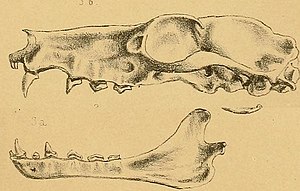Angola epaulette bat
| Angola epaulette bat | ||||||||||||
|---|---|---|---|---|---|---|---|---|---|---|---|---|

Angola epaulet bat ( Epomophorus angolensis ) |
||||||||||||
| Systematics | ||||||||||||
|
||||||||||||
| Scientific name | ||||||||||||
| Epomophorus angolensis | ||||||||||||
| Gray , 1870 |
The Angola epaulet bat ( Epomophorus angolensis ) is a fruit bat of the genus Epomophorus , which is endemic to southwestern Angola and northwestern Namibia .
description
The Angola epaulette bat weighs around 90 g and is a large bat species in West Africa with a head-to-trunk length of around 14.7 cm. Outwardly, the Angola epaulette bat is similar to Peters' epaulette bat ( E. crypturus ). The fur is light sand-colored to light brown on the top, it is pale in color underneath. The fur is white on the lower part of the auricle. The dark brown wings are sparsely hairy. The sexual dimorphism shows, among other things, in size and weight: the males are significantly heavier and larger than the females. In addition, only the males have the so-called epaulettes , i.e. white areas of fur on the shoulders that can be set up and presented for courtship. These white tufts of fur are not visible during periods of rest; they can be pulled back into special pockets.
distribution
The range of the Angola epaulette bat is very small and limited to the southwest of Angola and the extreme northwest of Namibia. Most of the evidence from Namibia exists in the Kunene area on the border with Angola. The northernmost finds come from the vicinity of Luanda in Angola.
Way of life
There is little data available on the Angola epaulette bat, so that there are no reliable findings on the ecology of the species. It is believed that the species occurs in evergreen forests such as gallery forests or mopane forests and consumes fruit.
Danger
The IUCN classifies the species as potentially endangered ("near threatened"), as preferred habitats are destroyed and the distribution area is very small.
literature
- Ara Monadjem , Peter John Taylor , FPD (Woody) Cotterill & M. Corrie Schoeman : Bats of Southern and Central Africa: A Biogeographic and Taxonomic Synthesis . 1st edition. Wits University Press, Pretoria 2010, ISBN 978-1-86814-508-9 .
Web links
- Epomophorus angolensis in the Integrated Taxonomic Information System (ITIS). Retrieved January 14, 2017.
- Epomophorus angolensis inthe IUCN Red List of Threatened Species 2016.3. Posted by: T. Mildenstein, 2016. Retrieved January 14, 2017.
Individual evidence
- ↑ a b c Monadjem et al. (2010). Pp. 76-79
- ↑ Victor Van Cakenberghe & Ernest CJ Seamark (eds.): ACR. 2016. African Chiroptera Report 2016. African Bats . 2016, ISSN 1990-6471 , p. 64-65 .
- ↑ Epomophorus angolensis in the IUCN Red List of Threatened Species 2016.3. Posted by: T. Mildenstein, 2016. Retrieved January 14, 2017.
